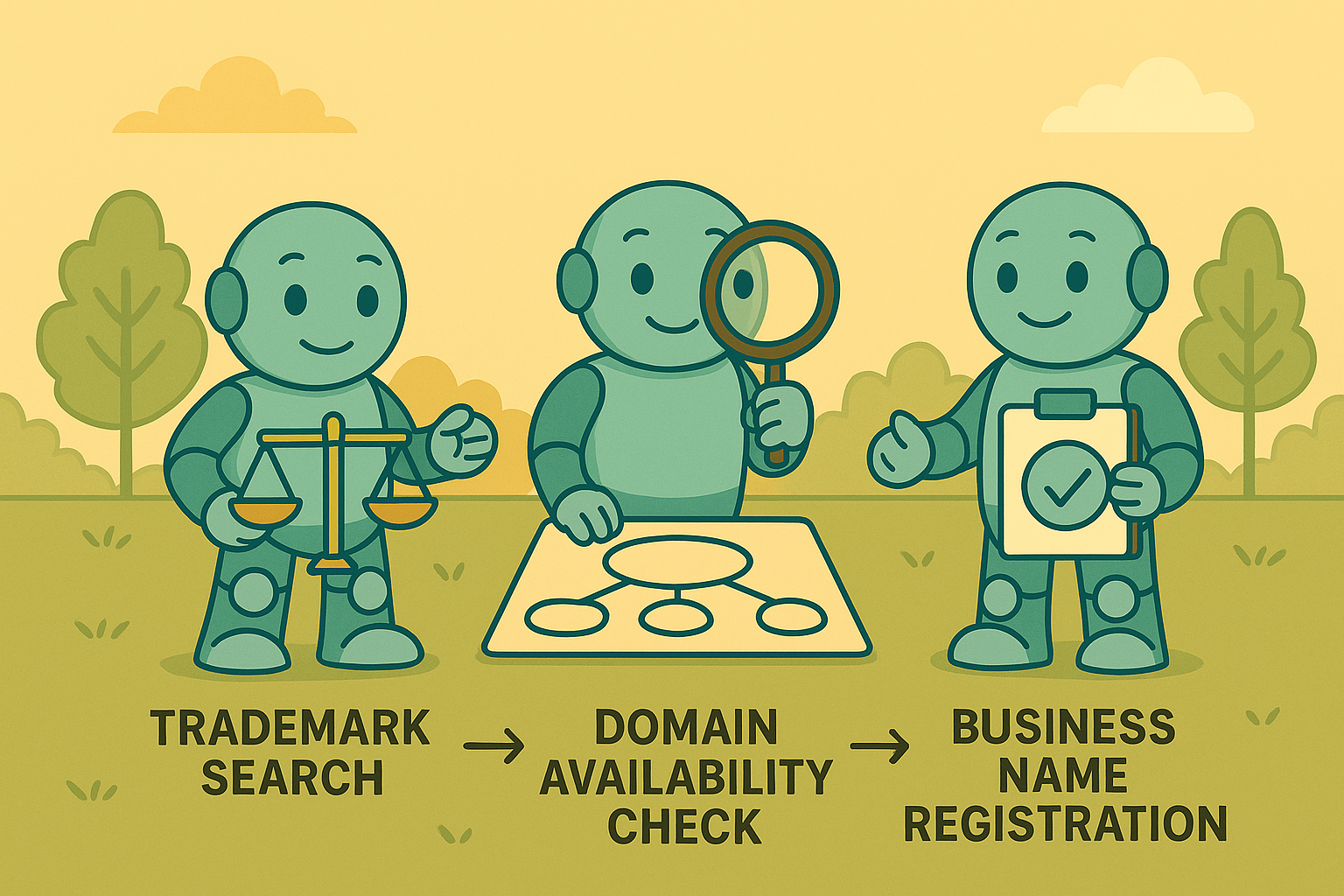Choose a Name for Business: Tips for a Strong Brand
Why Your Business Name Determines Long-Term Success
Choosing the right name for your business is a foundational step, not just a simple task to check off a list. It's the cornerstone of your brand identity, impacting how you attract customers and ultimately achieve lasting success. Your business name forms that crucial first impression and influences every subsequent interaction a customer has with your company. Understanding this impact from the beginning is essential.
The Power of a Strong Business Name
A carefully chosen name instantly communicates your brand's values, personality, and target market. Consider the example of "EcoClean Solutions," which immediately suggests a focus on environmentally conscious cleaning services. This clarity attracts the right customers from the outset. In contrast, a vague or confusing name can leave potential customers uncertain about your offerings, hindering your growth potential.
Furthermore, your business name plays a key role in brand recognition. Think of iconic brands like Nike or Apple. These names are short, memorable, and instantly recognizable worldwide. This instant recognition builds trust and familiarity, fostering customer loyalty and ultimately driving sales. A strong name amplifies your marketing efforts significantly.
Research shows a strong correlation between a business name and its success. Companies with memorable and meaningful names see up to a 36% higher customer retention rate compared to those with generic or difficult names. This data underscores the tangible business impact of a strategic naming decision. For a more in-depth look at brand naming strategies, see this Brand Naming Guide.
The Hidden Costs of a Weak Name
While the benefits of a strong name are evident, the costs of a weak one can be just as significant, albeit less apparent upfront. A poorly chosen name can limit your target audience, create market confusion, and even necessitate costly rebranding efforts later.
For example, a name that is too niche-specific might restrict your ability to expand your product or service offerings in the future. Imagine "Mobile Phone Repairs" deciding to branch into computer repair. The name suddenly becomes a constraint. A weak name can also make it difficult to secure a relevant domain name or social media handle, both vital for a strong online presence.
A name that is hard to pronounce or spell can also create customer frustration, making it harder for them to remember or recommend your business. This can lead to missed opportunities and lost revenue. Choosing the right name from the start is a crucial investment in your future.
Building a Lasting Legacy
Your business name is more than just a label – it's the foundation of your brand identity. It's what people will associate with your products, services, and company culture. Choosing a name that reflects your vision and connects with your target audience is essential for building a lasting legacy.
Investing time and effort in the naming process sets the stage for long-term growth and success. A strong name attracts investors, inspires employees, and cultivates a loyal customer base. Ultimately, selecting the right name is about shaping the future of your business. It's a decision that requires careful consideration and strategic planning.
Understanding the Psychology Behind Memorable Names

Choosing a business name is more than just finding an available domain. It's about understanding how people perceive and remember information. This involves delving into the psychology of naming to craft a brand name that truly resonates. A well-chosen name can subtly influence customer perception and forge a lasting connection with your brand.
The Science of Sound and Meaning
Phonetic symbolism plays a vital role in how we interpret names. Short, sharp sounds, like those in "Crisp," can suggest efficiency and modernity. Softer sounds, like those in "Lullaby," evoke comfort and tranquility. This inherent link between sound and meaning shapes customer perception before they even interact with your products or services.
Name structure also impacts memorability. Simple, easy-to-pronounce names like "Google" or "Spotify" are easily remembered. Complex or unusual names, however, are often quickly forgotten. Our brains prefer processing easily digestible and categorized information.
Emotional Resonance and Brand Perception
Effective names go beyond sound and structure, tapping into emotional triggers. Consider "Dove." The name evokes feelings of gentleness and purity, aligning perfectly with their products. This emotional connection creates a strong bond between customer and brand.
Linguistic patterns also influence perception. Formal language can project tradition and trustworthiness, which is particularly relevant for financial institutions or law firms. A more playful, informal name might suit a tech startup or children's clothing brand, conveying innovation and approachability.
Testing for Memorability and Subconscious Associations
Testing potential names is crucial. Online surveys or focus groups can gather feedback on audience perception. This helps uncover any negative associations or identify memorable names with positive connotations. Cultural interpretations can vary significantly, making this step particularly important.
A name that appears modern and sophisticated in one language might have a completely different meaning in another. This is a critical consideration for businesses with global aspirations. Tools like NameRobot can help navigate these complexities, enabling you to choose a memorable and culturally appropriate name. Learn more about how NameRobot can help with your business name here. Thorough testing ensures your chosen name aligns with your brand identity and resonates with your target audience on conscious and subconscious levels. A/B testing is another valuable tool for comparing name options and gathering data on customer preferences. By understanding the psychology of naming, you can create a brand name that not only stands out but also cultivates a deep and lasting connection with your customers.
Mastering Digital Naming In Today's Connected World

A compelling business name is essential, but it's only the first step. In our interconnected digital landscape, your chosen name must also perform effectively online. This includes factors like domain names, social media handles, and how search engines interpret your brand. Overlooking these elements can significantly hinder your online visibility and marketing efforts, potentially leading to missed opportunities and a difficult path to online success.
Domain Names And Social Media Handles
Securing a matching domain name and consistent social media handles is crucial. Imagine selecting a perfect name only to find the .com domain is unavailable. This scenario can cause customer confusion and make it harder for potential clients to find your business online. Similarly, inconsistent social media handles can fragment your online presence and weaken your brand identity.
For example, if your business is named "Blue Sky Innovations," the ideal scenario would be blueskyinnovations.com for your domain and @blueskyinnovations for your social media handles across different platforms. This consistency reinforces brand recognition and simplifies customer engagement. However, if these digital assets are unavailable, exploring alternatives might require compromising on your preferred name. This frequently leads businesses to add extra words or numbers, reducing the clarity and impact of the original name.
Search Engine Optimization (SEO)
Your business name also plays a vital role in Search Engine Optimization (SEO). SEO-friendly names that incorporate relevant keywords or are easily searchable online can increase organic search traffic by as much as 40%. Selecting a name that accurately represents your business and is easy for search engines to understand can dramatically affect your online visibility. A name that's difficult to spell or pronounce can negatively affect your SEO, making it harder for customers to search for you effectively. Learn more about SEO best practices in naming here.
Future-Proofing Your Name
The digital world is constantly evolving. Therefore, selecting a name adaptable to future trends is paramount. Avoid overly niche-specific names that could restrict your ability to broaden your products or services later. Consider the long-term implications of your chosen name across various languages and cultures. A name suitable for your local market might have unintended negative connotations elsewhere.
Tools And Strategies
Fortunately, various tools simplify the complexities of digital naming. Domain name checkers can instantly confirm availability, while social media monitoring tools help track brand mentions and identify potential conflicts. Comprehensive name analysis platforms offer insights into SEO potential, brandability, and international suitability. Strategically using these resources lets you select a name that resonates with your target audience and strengthens your long-term digital success, turning your chosen name into a valuable asset in the dynamic digital world.
Current Naming Trends That Actually Drive Results
The business naming landscape is constantly evolving. What resonated five years ago might now seem outdated. So, how do you choose a name that stands the test of time? It requires careful analysis of current trends and discerning lasting power from fleeting appeal. Understanding these nuances is key to selecting a name that positions your brand for enduring success.
Short, Punchy, and Descriptive: Finding the Right Balance
One significant trend is the rise of short, punchy names. Brands like Stripe, Trello, or Bolt exemplify this concise approach. These names are memorable and effective in digital spaces, offering a modern, sleek feel. Studies show that these one- or two-syllable names have gained immense popularity, not only for their memorability but also for their strong online performance. Explore this topic further.
However, descriptive names are also resurfacing, especially where clarity is paramount. "Green Energy Solutions," for example, instantly conveys the company's purpose. This directness can build trust and attract customers seeking specific services. The key lies in balancing conciseness and clarity to resonate with your target audience.
Tech-Inspired Names: A Double-Edged Sword
The use of tech-inspired names is also increasing, even outside the tech industry. Prefixes like "nano," "bio," or "cyber" project a sense of innovation. However, this tactic requires careful consideration. The name must align with the brand’s actual offerings and values. Using tech terminology for a traditional craft business, for instance, could create dissonance and confuse potential customers.
Avoiding the Fad Trap: Focus on Core Identity
While staying relevant is crucial, blindly following every trend can be detrimental. Today's trend might be tomorrow's cliché. A name that quickly becomes dated can lead to costly rebranding down the line. Prioritize a name that reflects your core brand identity over chasing fleeting trends.
Case Studies: Learning from Successes and Failures
Real-world examples offer invaluable lessons. Analyze brands that successfully incorporated naming trends and those that succumbed to fads. This provides critical insights. Consider companies that adapted their names effectively as their businesses evolved. These case studies provide actionable guidance for choosing a name that supports long-term growth. This strategic approach ensures your name strengthens your brand for long-term success. Resources like NameRobot offer further insights into effective naming strategies. Check out their resources here.
Your Complete Step-by-Step Naming Process
Choosing the right business name can feel like a daunting task. However, a structured approach can simplify this critical process. This guide breaks down proven naming methodologies, from initial brainstorming sessions to final evaluation, helping you select a name that positions your business for success.
Brainstorming For Creative and Effective Names
Begin by generating a wide range of potential names. Start with broad categories relevant to your business, and then list specific words within each. For example, if you're opening a coffee shop, categories might include "Coffee," "Community," and "Location." Then, list words like "roast," "brew," "gather," "neighborhood," and "downtown." Tools like NameRobot can also assist in generating names.
Next, combine words from different categories to create unique and compelling combinations. Don't hesitate to experiment with unusual pairings. The goal is to develop a diverse list of possibilities.
Evaluating Your Name Options: Key Criteria
Once you have a comprehensive list, evaluate each name against key criteria:
- Relevance: Does the name accurately reflect your brand identity and resonate with your target audience?
- Memorability: Is the name easy to remember, pronounce, and share with others?
- Availability: Are the corresponding domain name and social media handles available? This is crucial for establishing a consistent online presence.
- Legal: Is the name trademarkable and free of any copyright infringements? This protects your brand and avoids potential legal issues.
To objectively evaluate each potential name, a structured scoring system can be invaluable. The table below provides a framework for this evaluation.
Business Name Evaluation Framework A comprehensive scoring system to objectively evaluate potential business names across critical success factors
| Criteria | Weight | Score (1-10) | Weighted Score | Notes |
|---|---|---|---|---|
| Relevance | 30% | 8 | 2.4 | Example: Does the name clearly communicate the nature of the business? |
| Memorability | 25% | 7 | 1.75 | Example: Is the name easy to recall and pronounce? Is it catchy? |
| Availability | 25% | 9 | 2.25 | Example: Are the .com domain and relevant social media handles available? |
| Legal | 20% | 6 | 1.2 | Example: Has a trademark search been conducted? Are there any potential conflicts? |
This framework allows you to prioritize names based on a weighted scoring system, ensuring that the chosen name aligns with your business objectives and target market. Remember to fill in the scores and weighted scores based on your specific business and chosen names.
Market Research and Stakeholder Input
Conducting thorough market research is essential to validate your name choices. Surveys and focus groups can provide valuable insights into how your target audience perceives potential names. Gathering feedback from stakeholders, including employees and investors, is also important to ensure buy-in and alignment.
However, remember to balance stakeholder input with market data. While personal preferences are important, they shouldn't outweigh objective market feedback.
The Essential Legal and Digital Checks
Before finalizing your business name, conducting a comprehensive trademark search and domain availability check is paramount. These are essential steps to protect your brand and secure your online presence. The infographic below illustrates this crucial process:

This infographic highlights the importance of trademark searches, domain availability checks, and business name registration. These sequential steps protect your brand identity, secure your online presence, and prevent potential legal complications. Registering your chosen name is the final step in securing your brand identity.
Launching Your Chosen Name Strategically
Once you've selected your business name, launch it strategically. Announce it across all platforms, including your website and social media channels. Integrate your new name into your existing marketing materials for a consistent brand experience. Choosing a name for your business is a foundational step. A thoughtful and systematic approach to the naming process lays the groundwork for a strong and memorable brand.
Testing Your Name Before You Commit

After brainstorming and narrowing down your business name options, rigorous testing is essential. This critical step validates your choices and helps avoid costly rebranding efforts later. Testing provides actionable insights from your target market, going beyond casual feedback from friends and family. It ensures your chosen name resonates with potential customers and aligns with your brand vision.
Designing Effective Surveys and Focus Groups
Crafting effective surveys is key to gathering meaningful data. Keep surveys concise, focusing on specific aspects like memorability, relevance, and overall impression. Multiple-choice questions and rating scales, such as asking respondents to rate a name on a scale of 1 to 5 for memorability, offer quantifiable data for easier analysis.
Focus groups provide richer qualitative feedback. Assemble a representative group from your target audience and facilitate a structured discussion. Encourage open-ended responses to understand their perceptions and associations with each name. This direct interaction reveals valuable nuances missed by surveys.
Utilizing Digital Tools For Market Research
Digital tools provide robust methods for gauging market response. A/B testing allows direct comparison of different name options by presenting two names to separate audience segments and tracking metrics like click-through rates and engagement. This data-driven approach identifies the name that performs better in real-world scenarios.
Social media polls and online forums also offer valuable feedback. By posing questions about name preferences to your followers or relevant online communities, you can quickly gather insights from a broader audience, supplementing your survey and focus group findings.
International and Cultural Considerations
For businesses with global aspirations, international and cultural sensitivity is paramount. A name that resonates positively in one culture might carry negative connotations in another. Consulting with native speakers or cultural experts can prevent potential PR disasters. You might be interested in: How to master company naming strategy.
Interpreting Feedback and Making Informed Decisions
Effective interpretation is crucial after gathering feedback. Distinguish between personal preferences and market realities. Prioritize data-driven insights from your target audience over individual opinions, looking for recurring patterns and trends. A name consistently rated high on memorability and relevance across different testing methods signals a strong candidate.
Use a structured framework to analyze the different types of feedback. Assign weights to each testing method based on relevance and reliability. For example, feedback from focus groups representing your ideal customer profile might hold greater weight than casual social media polls.
To help visualize the strengths and weaknesses of each testing approach, consider the following comparison:
To better understand the different approaches to validating your business name, let's look at a comparison of various testing methods. The table below highlights the key factors to consider when choosing the right approach.
| Name Testing Methods Comparison | |||||
|---|---|---|---|---|---|
| Testing Method | Cost | Time Required | Sample Size | Best For | Reliability |
| Surveys | Low | Short | Large | Quantitative data | Medium |
| Focus Groups | Medium | Medium | Small | Qualitative data | High |
| A/B Testing | Medium | Short - Medium | Medium - Large | Direct comparison | High |
| Social Media Polls | Low | Short | Large | Broad reach | Low |
As you can see, each method has its own set of advantages and disadvantages. Choosing the right mix of methods will provide the most well-rounded understanding of your potential name's impact.
Testing Protocols, Sample Sizes, and Feedback Frameworks
Establishing clear testing protocols ensures consistent and reliable data. Define your target audience, select appropriate sample sizes, and document your methodology. Guidelines for sample sizes vary based on the method, but generally, larger sample sizes provide more statistically significant results.
Develop a scoring system to objectively evaluate names based on criteria such as memorability, relevance, and availability. This structured approach simplifies the assessment of each name's potential.
By thoroughly testing your chosen name, you significantly increase your chances of selecting a name that resonates with your target audience, strengthens your brand, and supports long-term success. A well-chosen name is an investment in your future. Dedicate the necessary time and effort to validate your choice through rigorous testing.
Protecting and Successfully Launching Your Chosen Name
After dedicating time and effort to choosing the perfect business name, the next crucial step is protecting it legally and launching it strategically. This often-overlooked phase can significantly impact your brand's success. It involves understanding trademarks, securing your online presence, and building a cohesive brand identity.
Understanding Trademark Basics
A trademark legally protects your brand name and associated elements, such as logos and slogans, preventing others from using similar identifiers. It's essential for establishing brand ownership and avoiding potential legal disputes.
Conducting a thorough trademark search is your first step. This confirms your chosen name isn't already registered or too similar to existing trademarks in your industry. While professional legal assistance is recommended, free online databases like the USPTO offer a preliminary assessment.
Trademark protection varies in scope. Federal trademark registration offers nationwide protection, while state-level registration provides protection within a specific state. Understanding these differences is crucial for selecting the appropriate level of protection.
Securing Your Online Presence
Once trademark considerations are addressed, securing your online presence is paramount. Register your chosen name as a domain name, ideally with a .com extension. This establishes a central online hub for your business.
Simultaneously, secure matching social media handles across relevant platforms. Consistent handles strengthen your brand identity and streamline customer engagement. If your exact name is unavailable, consider variations while maintaining clarity.
Protecting against cybersquatting is also vital. This occurs when individuals register domain names similar to yours with malicious intent. Monitoring for such activity and taking legal action, if necessary, protects your brand.
Building a Cohesive Brand Identity
Your chosen name forms the foundation of your brand identity. Building a cohesive brand involves extending your name's essence to all visual and messaging elements. This includes designing a logo, crafting a tagline, and ensuring consistent brand language.
Consider exploring resources like How to master creating a brand identity. This ensures every customer interaction reinforces your brand values and creates a memorable experience.
Launch Strategies for Maximum Impact
A well-planned launch amplifies your new name's impact. Consider the timing, aligning it with marketing campaigns or industry events for maximum exposure. Develop a clear announcement strategy using press releases, social media, and email marketing.
Seamlessly integrate your new name into existing marketing materials. Update your website, business cards, and other collateral. This consistency reinforces brand recognition and prevents customer confusion.
Long-Term Brand Management
Protecting and managing your business name is an ongoing process. Regularly monitor your trademark and online presence for infringements. Adapt your brand identity as your business evolves, ensuring your name remains relevant.
Ready to generate the perfect business name and launch your brand? NameRobot offers tools and resources to guide you through every step, from brainstorming to trademark protection.















